インターネットで蝉を追う第19章
|

トップセルは言う、「わたしはヘルヴェティア〔=スイス〕、ドイツ、イングランドをすべてを経巡り、1本の針を探すようにセミを探しまわったにもかかわらず、いまだ一匹も見つけられないのである」。
彼は、自分の国の南部、ニューハンプシャーのNew Forestという国立公園(現在)に、Cicadetta montana という正真正銘のセミが生息していることを知らなかった。はたして、ヨーロッパ中央にセミは生息しないのか?
最近、わたしたちは驚くべき書を手に入れた。
"Die Zikaden Mitteleuropas / The Auchenorrhyncha of Central Europe : Fulgoromorpha, Cacadomorpha excl. Cicadellidae", W.E. Holzinger, I. Kammerlander, H. Nickel, Brill, Leiden-Boston, 2003
この書の中から、セミにもバッタ類にも似ていて、しかもヨーロッパ全域に分布しているものを抜き出してみたい。
が、その前に、ヨーロッパ北部を除いてひろく分布している(分布図は右上図)"Cicadetta montana"〔ドイツ語名 Berkzikade〕の姿を心に焼きつけておこう。
画像の出典は、Songs of Cicadas。音声もこのサイトで聞ける。

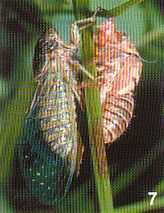 Cicadomorpha > Cicadidae > Tibicininae > Cicadetta montana
Cicadomorpha > Cicadidae > Tibicininae > Cicadetta montana
右以下の画像、および解説は、"Die Zikaden Mitteleuropas"から。
L〔Body length〕: 16-20 mm, incl. fore wings/Vorderfl[u]gel 23-28 mm, wing span/Fl[u]gelspannweite 45-52 mm
T〔Taxonomy, nomenclature, morphology〕: After Nast (1972), there are numerous synonyms available, and several subspecies have been described (see. above). According to Gogala & Trilar (1998, 1999) and Gogala (2002) this is a complex of several species, which are distinct mainly bioacoustically. Central European populations〔!!!〕 probably belong to at least two species. The song of one form is longlasting and continuous, with only short and irregular interruptions. Another form has a song consisting of two different and alternating echemes, the first of which lasts several seconds, the second is very short. A third species of this complex probably occurs in southernmost parts of central Europe (Gogala & Trilar, pers. commun.).
B〔Biology and ecology〕: E IV-M VII; Iv, perennial (at least 2 years). Among open stands of shrubs or trees in moderately dry to dry, sun-exposed sites〔!!!〕, usually on hillsides or plateaus, mainly in dry pastures and meadows and along sunny forest margins. Up to 1600 m.
V〔Distribution〕: Palaearctic. (p.481-482)
もちろん、いかにひろく分布していようと、それが人間(あるいは文化)と何の交渉も持っていなければ、存在しないのと同様である。はたして"Cicadetta montana"がどうであったのかは、わたしたちのこれからの探求課題である。
さて、この書によれば、Rhynchotaすなわち半翅目(Hemiptera)は、大きく、Cicado-morphaとFulgoro-morphaとに分かれる。
われわれのいう「セミ」は、前者のCicadidaeの中に属する。"Cicadetta montana"は、Cacadidaeのサブ・ファミリ"Tibicininae"に属する。
他方、Fulgoro-morphaの方は、さまざまなファミリや属に分かれるが、
1) Fulgoromorpha > Ciciidae > Cixius cunicularius〔ドイツ語名 Bush-Glasfl[u]gelzikade〕
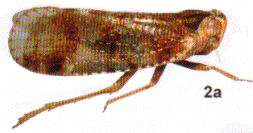
Ph.-Figs. 2a,2b: ♂
L: ♂ 5.8-6.9 mm, ♀ 6.2-7.4 mm
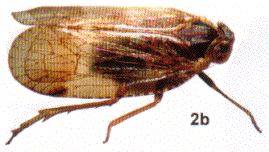 B: B V-E IX; Iv, I gen. Usually along sunny margins of forests and hedges; adults on various deciduous shrubs and trees (Salix, Corylus, Betula, Alnus, Ulmus and others). Up to at least 1200 m.
B: B V-E IX; Iv, I gen. Usually along sunny margins of forests and hedges; adults on various deciduous shrubs and trees (Salix, Corylus, Betula, Alnus, Ulmus and others). Up to at least 1200 m.
V: Palaearctic.(p.79)
2) Fulgoromorpha > Delphacidae > Javesella forcipata〔ドイツ語名 Zangenspornzikade〕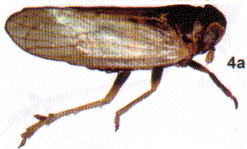
Ph.-Figs. 4a, 4d: ♂
L: 2.0-3.5 mm, ma. 3.3-4.0 mm

B: B V-B IX; Iv, I gen. In cool and moderately eutrophic, temporarily wet or flooded, shady to moderately shady sites, often with lush grassy vegetation (mountain and fen forests, forest meadows, tall herb stands, spring mires, etc.). On various grasses (Deschampsia cespitosa, Holcus mollis, probably also Poa trivalis, Calamagrostis canescens, Agrostis stolonifera). Up to at least 1500 m.
V: Palaearctic except the south.(p.317)
3) Fulgoromorpha > Delphacidae > Stiroma bicarinata〔ドイツ語名 Waldspornzikade〕 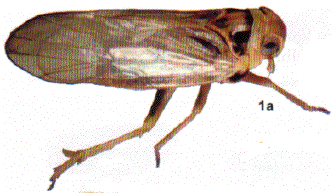
Ph.-Figs. 1a, 1d: ♂
L: br. 3-4 mm, ma. 4.5-5 mm
 B: M V-E VIII; Iv, I gen. Among rather tall grasses in moderately moist to wet sites, usually in abandoned or low-input meadows and pastures (in the lowlands only in cool valley bottoms or in the vicinity of shrubs and trees) , in deciduous and coniferous forests (in more moist and shady sites than S. affinis, but locally syntopic), and in subalpine pastures and tall herb stands. Often in tussocks of Deschampsia cespitosa, but also on other grasses (e. g. Holcus mollis, Glyceria maxima, Dactylis glomerata, Elymus repens, Arrhenatherum elatius). Up to 1800 m.
B: M V-E VIII; Iv, I gen. Among rather tall grasses in moderately moist to wet sites, usually in abandoned or low-input meadows and pastures (in the lowlands only in cool valley bottoms or in the vicinity of shrubs and trees) , in deciduous and coniferous forests (in more moist and shady sites than S. affinis, but locally syntopic), and in subalpine pastures and tall herb stands. Often in tussocks of Deschampsia cespitosa, but also on other grasses (e. g. Holcus mollis, Glyceria maxima, Dactylis glomerata, Elymus repens, Arrhenatherum elatius). Up to 1800 m.
V: Eurosiberian, absent from the Mediterranean region. (p.393)
 Barbaroi!
Barbaroi!